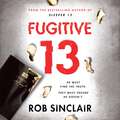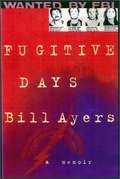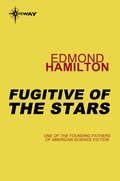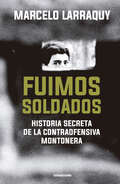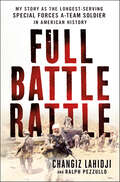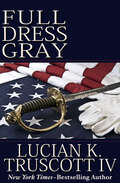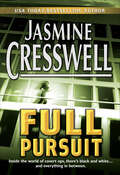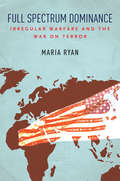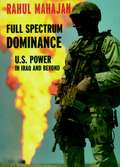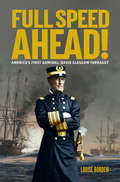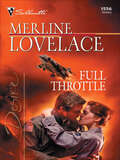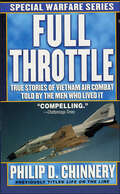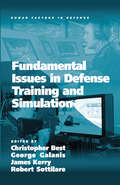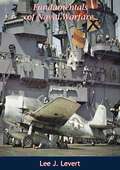- Table View
- List View
Fugitive 13: The second action-packed, thrilling instalment of the best-selling, gripping series (Sleeper 13 #2)
by Rob SinclairThe explosive second book in the SLEEPER 13 thriller series, by Rob Sinclair - for fans of Orphan X, I Am Pilgrim and Nomad.Aydin Torkal - aka Sleeper 13 - is on the run.Hunted not only by the world's intelligence agencies, but also by the elite brotherhood of insurgents he betrayed, he has lived the past year like a ghost.Until now.MI6 agent Rachel Cox knows Aydin better than anyone. The only person who believes he is an ally in the ongoing war on terror, not the enemy. So when a coded message arrives from him, warning her not to trust her own colleagues, Rachel must choose between her career and the truth.But as Aydin hunts down those who destroyed his childhood, the trail he follows will lead him closer to home than he ever expected.He won't stop until he has his revenge.He is FUGITIVE 13.
Fugitive Days: A Memoir
by Bill AyersAyers helped found the Weather Underground in the late 1960s in response to the horror of the Vietnam War. He recounts a decade of living as a fugitive, stealing explosives, hiding from the law, and losing his beloved Diana Oughton in an explosion. The 2001 edition was published by Beacon Press. Annotation ©2004 Book News, Inc. , Portland, OR (booknews. com)
Fugitive Son: A Memoir
by Aramís CalderónAramís Calderón was eleven in 1992 when federal marshals conducted a nighttime raid at the Baton Rouge apartment where he lived with his mother and four siblings. They were searching for Aramís&’s father, who had escaped from a nearby federal prison. Once satisfied with the answers from Aramís&’s mother, the marshals departed. At daybreak, so did Aramís&’s family—and drove toward a rendezvous with his father, who had fled to South Florida. Thus began an eight-month ordeal of constant moves, family aliases, and drug deals. As Calderón shares, Fugitive Son is not a love letter to his father, whom he sees even after his death as an unethical, toxic, and incredibly complex man. Rather, Calderón&’s memoir explores how his father&’s undeniable love for his family despite drug addiction, lawlessness, and toxic masculinity informed Aramís&’s rebellious decision to join the Marines, and how all this shaped his determination to become the father he wished his own had been.
Fugitive of the Stars
by Edmond HamiltonHorne, the spaceship's pilot, had been warned. "Don't forget the meteor swarm." And Horne's directional calculations for the Vega Queen's course took that advice into account; the spaceship would go fifteen thousand miles out of its way to avoid those deadly celestial rocks. But when Horne went off duty, he felt himself numbed by a curious druglike leadenness. And the next thing he knew, he was in a lifeboat, speeding away from the floating wreckage of the Vega Queen. Eighteen survivors out of one hundred and fifty-three passengers. And each one in the tiny space shell believed Horne responsible...deliberate negligence, calculated destruction...Someone had drugged Horne, he knew; someone had tampered with the ship to alter its course. But who? And for what cosmic purpose?
Fuimos soldados (Edición 2021): Historia secreta de la contraofensiva montonera
by Marcelo LarraquyDespués de las exitosas obras Galimberti y López Rega, Marcelo Larraquy reconstruye las historias de ese puñado de hombres y mujeres a los que se reconoce como desaparecidos pero no como soldados, y a quienes la manipulación política dejó afuera del canon de la memoria setentista. Lazarte, un combatiente rebelde, expulsado de la guerrilla montonera, quiere matar a los miembros de la Conducción, a quienes responsabiliza por la desaparición de su hermana durante la dictadura militar. Para cumplir con su plan, necesita ser reincorporado y recuperar la confianza de los dirigentes. Se ofrece entonces para realizar una acción heroica, a la que difícilmente pueda sobrevivir: volver a la Argentina para interferir las emisiones televisivas de los partidos del Mundial '78 y propagar el discurso del comandante montonero Mario Firmenich. Contra todos los pronósticos, Lazarte alcanza su objetivo. De regreso en México, Montoneros lo readmite en sus filas y lo pone al frente de un pelotón de soldados con el que viaja nuevamente al país a cumplir otra misión peligrosa. El pelotón cruza la frontera con identidades fraguadas e intenta sobrevivir en la clandestinidad. Le faltan armas y dinero; algunos soldados desertan, otros desaparecen, pero el grupo tiene objetivos para cumplir, y Lazarte no olvida el suyo. Como ellos, otros combatientes montoneros tomaron las armas y regresaron al país entre 1978 y 1980 para combatir a la dictadura militar, mientras la sociedad festejaba en las calles los triunfos futbolísticos de esos años. Casi ninguno sobrevivió.
Fuji Fire: Sifting Ashes of a Forgotten U.S. Marine Corps Tragedy
by Chas HenryOn October 19, 1979, the largest, most intense tropical cyclone ever recorded propelled 5,500 gallons of gasoline into corrugated steel huts filled with U.S. Marines. The gas ignited, injuring seventy-three people, thirteen of them fatally. The Marine Corps commandant, a veteran of combat in World War II, Korea, and Vietnam, was stunned as he met scores of horribly burned survivors. &“Having witnessed a lot of bad things, ugly things,&” the general declared, &“none can compare to that experience.&” And yet this 1979 catastrophe on the slopes of Japan&’s iconic Mount Fuji remains all but forgotten except by those directly affected. Now, the fruits of Chas Henry&’s exhaustive four-year, two-continent investigation provide insight into what many have called the U.S. Marine Corps&’ worst-ever peacetime disaster. Fuji Fire shares the compelling and intimate stories of heartbreak and inspiration forged by these events while bringing to light new, critical analyses of the incident&’s causes and effects.
Full Battle Rattle: My Story as the Longest-Serving Special Forces A-Team Soldier in American History
by Ralph Pezzullo Changiz LahidjiOver 100 combat missions, 24 years as a Green Beret—Full Battle Rattle tells the legend of a soldier who served America in every war since Vietnam.Master Sergeant Changiz Lahidji served on Special Forces A teams longer than anyone in history, completing over a hundred combat missions in Afghanistan. Changiz is a Special Forces legend. He also happens to be the first Muslim Green Beret. Changiz served this country starting with Operation Eagle Claw in 1980, when he entered Tehran on a one-man mission to spy on Iranian soldiers guarding the US Embassy where 52 US diplomats were being held hostage. Three years later, he was in Beirut, Lebanon when a suicide car bomb exploded in front of the US Embassy killing 83 people. Weeks after that, he was shot by Hezbollah terrorists on a night mission. In Operation Iraqi Freedom, he led a convoy that was ambushed on its way to Fallujah. He was clearing houses in Mogadishu, Somalia on October, 1993 when a US Black Hawk helicopter was shot down 50 feet away from him in the incident that inspired Black Hawk Down. In 2002, he dressed as a farmer and snuck into Eastern Afghanistan and located Osama Bin Laden for the CIA. Along the way, Changiz earned numerous commendations, including the Special Forces Legion of Merit, Purple Hearts, and many others. Last year he was nominated for induction in Military Intelligence Hall of Fame and cited as “the finest noncommissioned officer to ever serve in Special Forces.” His story is an amazing tale of perseverance and courage, of combat and one man’s love of his adopted country.
Full Circle
by J. E. JohnsonUnique among all the books about war in the air, this is the only complete account of the tactics of fighter aircraft from the beginning to the end, told by the top-scoring Allied fighter pilot. It begins with the first exciting air dogfights in World War I, when 70 mile-an-hour biplanes lumbered through the sky in single encounters over France. It traces' the swift development of higher performance fighter planes between the wars, and shows how British, German, and American pilots sharpened their skills in the vastly more powerful and heavily armed fighters of World War II. A final fascinating section describes the further evolution of fighter tactics in the era of supersonic jets-the last manned fighter planes the world will ever see.
Full Circle (Star Trek: Voyager)
by Kirsten BeyerFollowing the events of the unforgettable Star Trek crossover trilogy Destiny, the new captain of the USS Voyager embarks on a dangerous mission that is paved with blood and haunted by ghosts of the past.When the USS Voyager is dispatched on an urgent mission to the planet Kerovi, Captain Chakotay and his first officer, Commander Thomas Paris, must choose between following their orders and saving the lives of two of those dearest to them. B&’Elanna Torres and her daughter, Miral, are both missing in the wake of a brutal attack on the Klingon world of Boreth. With the aid of their former captain, Admiral Kathryn Janeway—as well as many old friends and new allies—the crew must unravel an ancient mystery, placing themselves between two warrior sects battling for the soul of the Klingon people...while the life of Miral hangs in the balance. But these events and their repercussions are merely the prelude to even darker days to come. As Voyager is drawn into a desperate struggle to prevent the annihilation of the Federation, lives are shattered, and the bonds that were forged in the Delta Quadrant are challenged in ways that none could have imagined. For though destiny has dealt them crushing blows, Voyager&’s crew must rise to face their future...and begin a perilous journey in which the wheel of fate comes full circle.
Full Dress Gray
by Lucian K. TruscottA female cadet has collapsed and died while parading past the reviewing stand on a hot September morning. The autopsy establishes that she'd had sex with three different men the night before. Some claim that it's evidence of a major military scandal. Superintendent Ry Slaight fears it may be evidence of a shocking crime. His daughter-a cadet herself-is endangering her life in a quest for the truth. And among those who know that truth, the watchword is Don't ask, don't tell. . . .
Full Dress Gray
by Lucian K. Truscott IVThe death of a female cadet rocks West Point in this People Magazine &“Beach Book of the Week&” from the New York Times–bestselling author of Dress Gray. A female cadet has collapsed and died while parading past the reviewing stand on a hot September morning. The autopsy establishes that she had sex with three different men the night before. Some claim that it&’s evidence of a major military scandal. Superintendent Ry Slaight fears it may be evidence of a shocking crime. His daughter—a cadet herself—is endangering her life in a quest for the truth. And among those who know the truth, the watchword is don&’t ask, don&’t tell . . .
Full Exposure
by Sara Jane StoneNo touching allowed ... After serving her country, Georgia Trulane craves adventure--and sex. She's set her sights on her brother's best friend--now her boss, since she took a temporary job as his nephew's live-in nanny. Only problem? Eric refuses to touch her. That doesn't stop Georgia from seducing him. But an earth-shattering encounter leaves her fully exposed, body and soul.Eric has a long list of reasons to steer clear of the woman he has wanted for as long as he can remember. For one, he refuses to be her next thrill ride. When he claims her, it will be for good. But the attraction is undeniable, and the more they fight it, the stronger it pulls. But will it be enough to conquer their obstacles?
Full Force: Tangled Threat / Full Force (declan's Defenders) (Declan’s Defenders #3)
by Elle JamesShe saw something she shouldn’t have…Now they want her dead.Ever since she left the foreign embassy where she was working, translator Emily Chastain has been targeted by someone who wants to silence her permanently. Fearing for her life, Emily contacts Declan’s Defenders and is placed under former marine Mustang Ford’s protection. If only she could figure out why someone is trying to kill her—and how to contain her unlikely attraction to Mustang…
Full Pursuit (Unit One)
by Jasmine CresswellDEEP IN RURAL IDAHO, A BRIGADE OF MILITANTWHITE SUPREMACISTS CALLING THEMSELVESTHE SOLDIERS OF JORDAN IS PREPARING TO LAUNCHA DESPERATE STRUGGLE THAT THREATENS TOFOREVER ALTER THE NATION’S BALANCE OF POWER.When the country’s ultrasecret Unit One goes on highalert, operative Melody Beecham is ordered to infiltrate theSoldiers of Jordan. Her instructions: to exploit their leader’spenchant for attractive Aryan-featured blondes.Fellow operative Nikolai Anwar is working from anotherangle: he must win the trust of a high-powered senator’swife in order to uncover a trail of corruption tied to thegovernment-through whatever means necessary. ButNikolai’s dedication to Unit One is in direct opposition to hisgrowing feelings for Melody.Working undercover, Nikolai and Melody are both orderedto pursue relationships with other people for the sake of themission. But can they survive in a world of hidden agendas,where one false move could be their last?
Full Spectrum Dominance: Irregular Warfare and the War on Terror
by Maria RyanAmerica's war on terror is widely defined by the Afghanistan and Iraq fronts. Yet, as this book demonstrates, both the international campaign and the new ways of fighting that grew out of it played out across multiple fronts beyond the Middle East. Maria Ryan explores how secondary fronts in the Philippines, sub-Saharan Africa, Georgia, and the Caspian Sea Basin became key test sites for developing what the Department of Defense called "full spectrum dominance": mastery across the entire range of possible conflict, from conventional through irregular warfare. Full Spectrum Dominance is the first sustained historical examination of the secondary fronts in the war on terror. It explores whether irregular warfare has been effective in creating global stability or if new terrorist groups have emerged in response to the intervention. As the U.S. military, Department of Defense, White House, and State Department have increasingly turned to irregular capabilities and objectives, understanding the underlying causes as well as the effects of the quest for full spectrum dominance become ever more important. The development of irregular strategies has left a deeply ambiguous and concerning global legacy.
Full Spectrum Dominance: U. S. Power in Iraq and Beyond (Open Media Series)
by Rahul MahajanIn this compelling big-picture assessment of the U.S. war on Iraq, Mahajan combines his experience as an anti-Iraq sanctions activist with a keen analysis of U.S. foreign policy in the post-Cold War era to provide the analysis that has been overlooked in the mainstream debate. Situating Iraq within the larger context of post-9/11 foreign policy, he analyzes the Bush National Security Strategy and the new neoconservative vision of achieving increasing degrees of global domination and control. Presented with unflinching clarity, Mahajan's research demonstrates that the war on Iraq was part of a much larger plan, assembled before 9/11 and, as stated by the Project for a New American Century, needing only a "new Pearl Harbor" to implement it.
Full Speed Ahead!: America's First Admiral: David Glasgow Farragut
by Louise BordenDiscover the man behind everyone's favorite call to action, "Full speed ahead!" in this inspiring and engaging biography about the first Admiral of the United States Navy, David Glasgow Farragut.At the age of nine, David Glasgow Farragut was appointed a midshipman in the US Navy by President James Madison. It was the start of a celebrated career. Farragut sailed aboard ships along the Delaware River, in the Caribbean, and across the Atlantic Ocean, even rounding the tip of South America, all while rising through the naval ranks from midshipman to admiral. When the Civil War began, Captain Farragut dedicated his life to protecting the United States as it was being torn in two. When President Lincoln asked him to capture New Orleans, the city Farragut once called home, and later to take Mobile Bay, the officer had only one order for his fleet: Full speed ahead! Noted nonfiction writer Louise Borden's in-depth research uncovers a man dedicated to his country -- a man who earned the title of America's first admiral.
Full Throttle (Black Knights Inc. #7)
by Julie Ann Walker"This is a one-sitting read, a welcome addition to the Black Knights, Inc. series, and a must for military romance fans."—BooklistThey may get a second chance—if they can make it out of the jungle alive.Carlos "Steady" Soto's nerves of steel have served him well at the covert government defense firm Black Knights Inc. But nothing has prepared him for the emotional roller coaster of guarding the woman he once loved and lost.Abby Thomson is content to leave politics and international intrigue to her father—the President of the United States—until she's taken hostage half a world away, and she fears her father's policy of not negotiating with terrorists will be her death sentence. There's one glimmer of hope: the man whose heart she broke, but she can ever tell him why.Black Knights Inc. SeriesHell on Wheels (Book 1)In Rides Trouble (Book 2)Rev It Up (Book 3)Thrill Ride (Book 4)Born Wild (Book 5)Hell for Leather (Book 6)Full Throttle (Book 7)Too Hard to Handle (Book 8)Wild Ride (Book 9 — coming April 2017!)Praise for Hell for Leather:"Deft characterization, red-hot chemistry, and a satisfying finish demonstrate Walker's mastery."—Publishers Weekly
Full Throttle (To Protect and Defend #2)
by Merline LovelaceTEMPERATURE'S RISING…and it had nothing to do with the weather! For when hurricane hunter Kate Hargrave met hotshot test pilot Dave Scott, everything started heating up. But it was a warming trend cautious Kate—once burned by her philandering ex—was determined to ignore at all costs. Because Dave's love-'em-and- leave-'em reputation was a label she was finding all too familiar….Air force pilot Dave Scott had had an eye for the ladies to be sure—but that was in the past. For once he saw the sexy, gorgeous researcher assigned to be his partner on the Pegasus Project, he knew that he was meant to be a one-woman man. Now if he could only convince the skittish Kate that appearances could be deceiving….
Full Throttle: True Stories of Vietnam Air Combat Told by the Men Who Lived It (Special Warfare Series)
by Philip D. ChinneryAirmen in Vietnam weren't above the hell of war-but they went beyond the call of duty.It was America's longest, most withering war, as hellish in the air as it was on the ground. But little has been told of the airmen who fought, who died, who lived and dared to remember...until now. Three dozen airmen tell their secret stories of the air war in Vietnam the only way it ought to be told: in their own words. In this brutally accurate picture of brave men fighting a tragic war-a portrait that touches upon every branch of the armed forces-aviation journalist Philip D. Chinnery's Full Throttle finally honors the heroes who have been nearly forgotten.
Full of Heart: My Story of Survival, Strength, and Spirit
by J. R. Martinez Alexandra Rockey FlemingAn inspirational journey from tragedy to triumph In 2003, nineteen-year-old Private J. R. Martinez was on a routine patrol when the Humvee he was driving hit an antitank mine in Iraq, resulting in severe injuries and burns on his face and more than one-third of his body. Out of that tragedy came an improbable journey of inspiration, motivation, and dreams come true. In Full of Heart, Martinez shares his story in intimate detail, from his upbringing in the American South and his time in the Army to his recovery and the indomitable spirit that has made him an inspiration to countless fans. J. R. Martinez always had a strong spirit. Raised in Bossier City, Louisiana, and then Hope, Arkansas, by a single mother from El Salvador, he was well known at school for his good looks and his smart mouth. At seventeen, showing an early determination and drive that would become one of his trademark qualities, J. R. convinced his mom to move to Dalton, Georgia, where he believed he would have a better chance of being recruited to play college football. His positive attitude earned him a spot on a competitive high school football squad, but when his college dreams collapsed, he turned to the U. S. Army. A few months later, he found himself serving in Iraq. When J. R. 's humvee hit a mine and exploded--just one month into his deployment--he was immediately evacuated to a San Antonio medical center, where he spent the next thirty-four months in grueling recovery. Seeing his disfigured face for the first time after the accident threw him into a crushing period of confusion and anger. His spirits were low, until he was asked to speak to another young burn victim. J. R. realized how valuable and gratifying it was to share his experiences with other patients and listen to theirs. He'd found a calling. His fellow soldiers, along with the local and then national media, soon latched onto J. R. 's spirit and strength. His resilience, optimism, and charm were also noted by Hollywood and scored him roles on All My Children and Dancing with the Stars, where he was the season thirteen champion. Today, J. R. tours the country sharing his story and his lessons for overcoming challenges and embracing hope, lessons that abound in this book. Full of Heart is an unforgettable story of a man who never gave up on his dreams. After being injured in Iraq, J. R. Martinez became a motivational speaker, actor, and winner of season thirteen of Dancing with the Stars. Martinez lives in Los Angeles
Functional Coexistence in Socio-Political Conflict: Enabling Social Change Across Decades (Routledge Studies in Peace and Conflict Resolution)
by Tatsushi Arai Margarita TadevosyanThis book introduces the concept of functional coexistence as a context for building practical strategies for long-term conflict intervention and social change.Functional coexistence is a pragmatic relationship of mutual non-recognition sustained in the absence of physical violence. In this volume, a team of internationally recognized scholar-practitioners of peacebuilding presents seven in-depth case studies of functional coexistence, expanding its potential for practical conflict intervention. Bridging theory to evidence and vision to practice, the book offers guideposts for sustained conflict intervention, presents compelling examples of peace potential within the context of functional coexistence, and identifies common pathways for change among them. It also proposes a customized framework for program evaluation and highlights the merit of long-term policymaking and funding. Instead of losing hope based on traditional expectations of conflict resolution and reconciliation, this pioneering study of conflict non-resolution demonstrates the power of tenacious pragmatism, strategically guided by a decades-long historical view of social change.This book will be of interest to students of conflict resolution, peacebuilding, international relations, foreign policy, and security studies.The Open Access version of this book, available at http://www.taylorfrancis.com, has been made available under a Creative Commons Attribution-Non Commercial-No Derivatives (CC-BY-NC-ND) 4.0 license.
Fundamental Issues in Defense Training and Simulation (Human Factors in Defence)
by George Galanis Robert SottilareDefense forces have always invested a great deal of their resources in training. In recent times, changes in the complexity and intensity of operations have reaffirmed the importance of ensuring that warfighters are adequately prepared for the environments in which they are required to work. The emergence of new operational drivers such as asymmetric threats, urban operations, joint and coalition operations and the widespread use of military communications and information technology networks has highlighted the importance of providing warfighters with the competencies required to act in a coordinated, adaptable fashion, and to make effective decisions in environments characterized by large amounts of sometimes ambiguous information. While investment in new technologies can make available new opportunities for action, it is only through effective training that personnel can be made ready to apply their tools in the most decisive and discriminating fashion. There are many factors which can have an impact on the efficacy of training and many issues to consider when designing and implementing training strategies. These issues are often complex and nuanced, and in order to grasp them fully a significant investment of time and energy is required. However, the requirement to respond quickly to ever-changing technology, a high operational tempo and minimal staffing may preclude many in today's defense forces from seeking out all such resources on their own. This edited collection provides brief, easy-to-understand summaries of the key issues in defense training and simulation, as well as guidance for further reading. It consists of a collection of short essays, each of which addresses a fundamental issue in defense training and simulation, and features an up-to-date reference list to enable the reader to undertake further investigation of the issues addressed. In essence, this book provides the optimum starting point, or first resource, for readers to come to terms with the important issues associated with defense training and simulation. The contributions are written by leading scholars from military research institutions in the US, UK, Canada, Australia and New Zealand, as well as selected researchers from academic and private sector research institutions.
Fundamentals of Naval Warfare
by Lee J. Levert William T. BradyAn outline of the principles and methods of naval warfare, comprehensive and excellently organized, this book will interest the general public as well as naval personnel.Intended for the general reader, Fundamentals of Naval Warfare is a plea for better understanding of the facts about naval warfare in order to support security measures. Ships and bases need trained personnel—the cost of unpreparedness is high. Here is a summary of the history of war, of weapons, of ships, of battles. Here is a discussion of the tactics of shore installations, base planning, harbor defense, employment in naval warfare, amphibious warfare, engineering problems, staff work, logistics, etc.Lieutenant-Commander Lee J. Levert carefully avoids any implication of personal bias, speaking only rarely of specific officers. He presents sample problems in planning and execution of plans to illustrate his points. He feels we have reached the twilight of carriers, as such, and presents the ideal ship-a combination of a battleship and a carrier, in one.Fundamentals of Naval Warfare is primarily a book for students of strategy and tactics, of naval warfare—and for armchair admirals.
Funding the Enemy
by Douglas A. WissingWith the vague intention of winning hearts and minds in Afghanistan, the US government has mismanaged billions of development and logistics dollars, bolstered the drug trade, and dumped untold millions into Taliban hands. That is the sobering message of this scathing critique of our war effort in Afghanistan. According to this book, America has already lost the war. While conducting extensive research and fieldwork in Afghanistan's war zones, a drumbeat of off-the-record and offhand remarks pointed the author to one conclusion: "We blew it." The sentiment was even blazoned across a US military fortification, as the author saw at Forward Operating Base Mehtar Lam in insurgency-wracked Laghman Province: "I glanced over at a concrete blast barrier while waiting for a helicopter," Wissing says. "Someone had spray-painted in jagged letters: 'The GAME. You Lost It.'" The author's vivid narrative takes the reader down to ground level in frontline Afghanistan. It draws on the voices of hundreds of combat soldiers, ordinary Afghans, private contractors, aid workers, international consultants, and government officials. From these contacts it became glaringly clear, as the author details, that American taxpayer dollars have been flowing into Taliban coffers, courtesy of scandalously mismanaged US development and counterinsurgency programs, with calamitous military and social consequences. This is the first book to detail the toxic embrace of American policymakers and careerists, Afghan kleptocrats, and the opportunistic Taliban. The result? US taxpayers have been footing the bill for both sides of a disastrous Afghanistan war.
